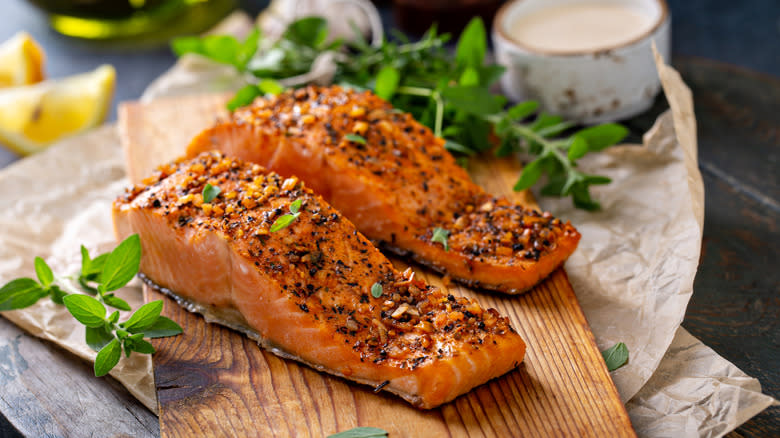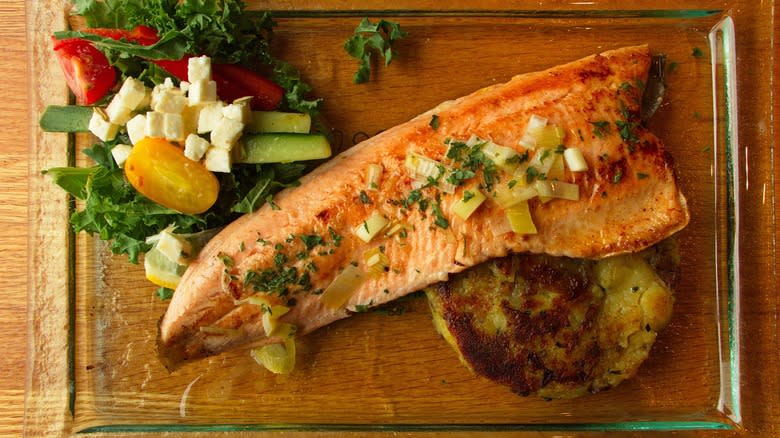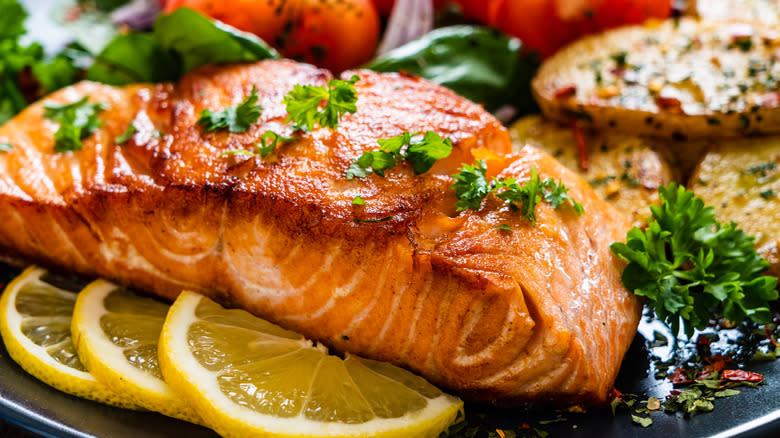The Flavor Differences Between Arctic Char Vs Salmon

There are a surprising number of people who claim they just don't like any seafood. This is especially wild since there are so many types of seafood and they taste so drastically different -- you'd think there'd be something for everyone. Sometimes different fish do have some flavor similarities, though, and such is the case with Arctic char and salmon.
It's no surprise there are overlaps between the two; salmon and Arctic char are closely related, and they have similar geographic ranges. But while there are certainly some flavor commonalities between them -- both have a noticeable sweetness and buttery texture, along with an oily quality -- they're also distinct enough that if you've had both before, you're not likely to mistake one for the other. Mainly, it comes down to mildness: Arctic char is generally going to have a significantly more delicate taste than even the milder varieties of its deeper-orange cousins in the salmon family.
Read more: 12 Underrated Types Of Fish You Should Try At Least Once
Arctic Char Is The Pick For People Who Don't Want Something Too Fishy

While salmon is enjoyed in different ways all around the world, its unifying quality is probably its noticeable richness and buttery consistency, along with its distinct sweet (and sometimes nutty) notes. Arctic char, meanwhile, has a lot of the same buttery qualities because both it and salmon are relatively fatty, and it too is sweet -- but it's generally significantly milder than salmon. It also possesses a slight earthiness that sets it apart. Arctic char is probably the better pick if you want something with a less fishy taste, while salmon is a good option if you want something that will bring a stronger ocean bite.
Some people actually believe Arctic char actually tastes more like trout (its other close cousin) than it does salmon. Trout also has a sweet, nutty quality, and Arctic char shares its more flaky consistency. But how close either of them is to salmon also depends on which salmon species you're talking about, because there isn't just one.
Different Types Of Salmon Have Different Flavor Profiles

Different salmon varieties taste more similar to each other than they do to, say, swordfish, but you still can't ignore the flavor differences between them. Coho is the mild variety of salmon that even fish-haters should try, meaning it's closer to Arctic char than any other type. Chum salmon isn't far behind, as it's also quite mild, though it's texturally softer than other types of salmon.
Some other kinds tend to range a little farther away from mild flavors, though, and thus further from Arctic char. Sockeye in particular has a noticeably strong flavor along with a meatier texture than its cousins. King salmon's flavor profile varies depending on where and how it's caught, but it's always got a ton of flavor. There's even a sub-category of King salmon called Ora King, a salmon variety chefs call "the wagyu of the sea" that's known for being unusually buttery even by salmon standards.
Since Arctic char is just one species, there's going to be less variance in its flavor. And if you're looking for types of salmon you can most easily substitute for Arctic char, you'll probably want to stick with either Coho or Chum.
Read the original article on Daily Meal

